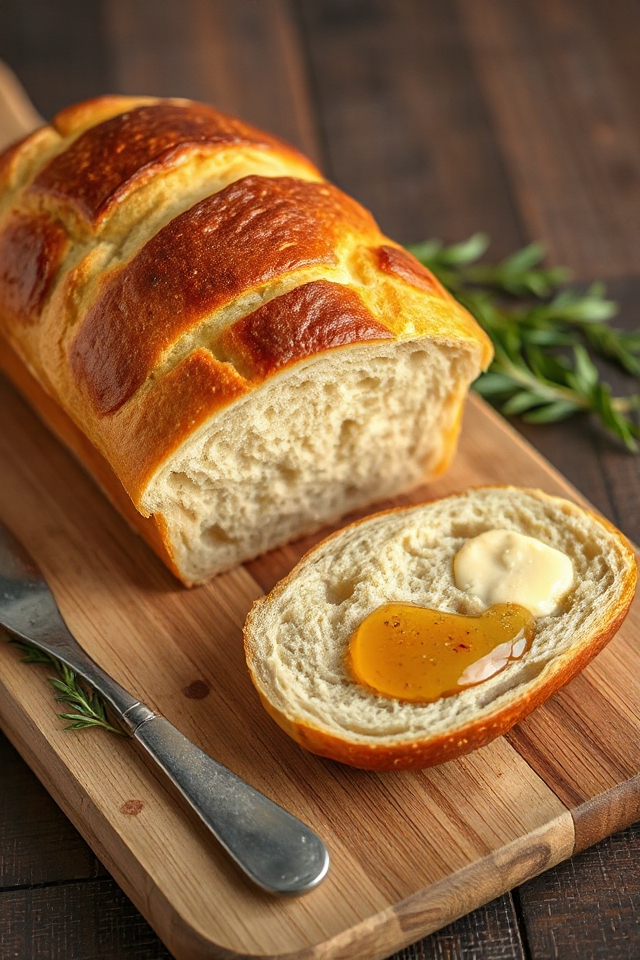Why You’ll Love This Homemade Bread Recipe
Homemade bread is more than just a delightful treat; it’s an experience that fills your kitchen with warmth and a comforting aroma.
I can’t help but love the process—mixing, kneading, and waiting for that dough to rise. There’s something magical about watching it double in size, a clear sign of life and promise.
The moment it bakes, the scent wafts through the house, beckoning everyone to gather.
And when you finally slice into that golden loaf, the crust crackles, revealing soft, fluffy insides.
It’s not just bread; it’s love, memories, and the joy of sharing something homemade with family and friends.
Ingredients of Homemade Bread
When you think about making homemade bread, the first step is gathering all the right ingredients. It’s a bit like putting together a puzzle: each piece is important to create that perfect loaf. With just a handful of simple ingredients, you can whip up something truly delicious. Plus, there’s something incredibly satisfying about knowing exactly what goes into your bread.
So, let’s explore what you’ll need.
Ingredients for Homemade Bread:
- 1 tablespoon active dry yeast
- 2 cups water, warmed
- 1 tablespoon sugar
- 1/4 teaspoon salt
- 5 1/2 cups all-purpose flour (or bread flour)
Now, I’ve to admit, when I first started baking, I was a little overwhelmed by the thought of yeast. Seriously, it seemed like such a mysterious ingredient. But fear not—it’s not as scary as it sounds. The yeast is the magic behind the rising dough.
And let’s talk about the flour for a second. While I love the idea of whole-wheat bread, I’ve found that using all-purpose or bread flour gives you that classic fluffy texture that we all crave. If you’re feeling adventurous, you can experiment with different types of flour later, but for your first loaf, stick with what works.
How to Make Homemade Bread

Making homemade bread is one of those magical processes that can turn your kitchen into a cozy little bakery. Trust me, once you get started, you’ll find it hard to resist the urge to whip up batch after batch. So, let’s explore how to make this delightful loaf.
First, grab 1 tablespoon of active dry yeast and sprinkle it into 2 cups of warm water. It’s like giving the yeast a little spa day—warm water helps it wake up and get all bubbly. Stir in 1 tablespoon of sugar until it dissolves. This sugar is like a sweet little snack for the yeast, and it’ll help your bread rise beautifully.
Now, add in 1/4 teaspoon of salt. This might seem small, but it’s essential for flavor. Then, it’s time to bring in the star of the show: 5 1/2 cups of all-purpose or bread flour. Add the flour one cup at a time, mixing as you go, until the dough starts to come together.
Once you have a dough that’s ready to be kneaded, dust your countertop with a bit of flour and get your hands in there. Knead the dough for about 5 to 10 minutes. I like to think of it as a mini workout; it’s good for the arms and a great way to let off some steam.
After kneading, place the dough in a large bowl that you’ve sprayed with olive oil spray—turn it around to coat it in oil, so it doesn’t stick. Cover it with a damp cloth and put it in your oven, turned off but still warm (think cozy, not hot). Let it rise for about an hour, or if you’re feeling impatient (like my kids), 45 minutes will do.
When the dough has doubled in size, give it a punch down to release the air and let your kids have some fun shaping it into loaves or rolls. If you brush the tops with an egg mixed with a tablespoon of water, it’ll give your bread that golden, crispy crust we all love.
After letting your shaped dough rise for another half hour, preheat your oven to 400 degrees. Bake for about 25 minutes, and then—oh, the smell!—you’ll have freshly baked bread that’s warm and inviting.
Serve it up with a mix of margarine, honey, and brown sugar for a delicious treat. Just remember, this bread is best enjoyed the day it’s made. But if it happens to stick around, a quick zap in the microwave for 10 seconds can bring it back to life. Enjoy the process, and don’t be too hard on yourself—it’s all part of the joy of homemade bread.
Homemade Bread Substitutions & Variations
Exploring substitutions and variations for your bread recipe can be just as rewarding as baking the bread itself.
If you’re out of all-purpose flour, try using bread flour for a chewier texture or a mix of whole wheat for added flavor.
For a dairy-free option, substitute the egg wash with a plant-based milk.
Want to spice things up? Add herbs, garlic, or cheese into the dough for a savory twist.
You can even experiment with sweeteners; honey or maple syrup can replace sugar.
Each variation opens a door to new flavors, making your homemade bread uniquely yours!
Additional Tips & Notes
Although baking bread can seem intimidating, a few extra tips can make the process smoother and the results even tastier.
First, make sure your water’s warm but not hot; this keeps the yeast happy. Kneading can be a workout, so don’t hesitate to let your kids join in—they’ll love it!
For a golden crust, brush the dough with the egg wash before baking. If you want to infuse flavors, try adding herbs or garlic.
Finally, for the best taste, enjoy your bread warm and fresh. If you have leftovers, a quick zap in the microwave revives it beautifully!
